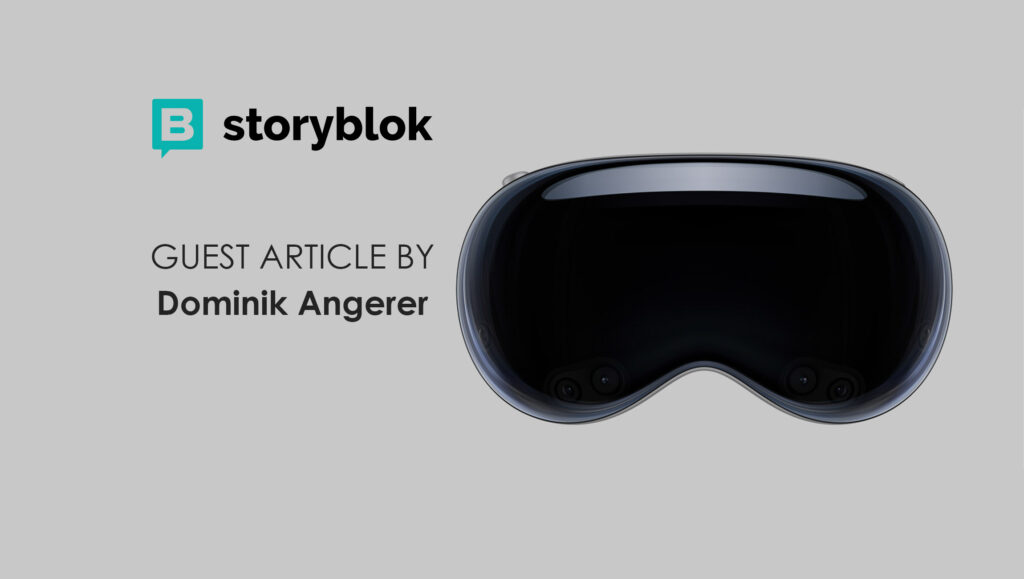Dominik Angerer, CEO and co-founder of headless CMS Storyblok, discusses the potential Apple’s VR headset offers to unleash a new era of immersive retail.
Last month, Apple announced its first major product line since the Apple Watch in 2015 following years of speculation. Over a decade in the making, the Apple Vision Pro is a cross between an immersive headset and AR glasses, and can be controlled by users’ hand gestures, eye movements or voice controls. Launching in 2024, Apple describes it as a “revolutionary spatial computer that seamlessly blends digital content with the physical world,” while saying it “lets users interact with digital content in a way that feels like it is physically present in their space.”
And the expert consensus is that it has the potential to be the game-changer that the tech world has been waiting for. In fact, a recent survey conducted by Storyblok suggests that 60 percent of business executives believe that the Apple headset will be an ‘iPhone moment’ for VR and AR.
For retailers, of course, this raises all types of questions. Principally, what does it mean for the future of retail, and how can I become part of it?
To answer the first question, the good news is this technology will bring with it – quite literally – a whole new world of opportunity. Take, for example, the retail experience. While social media platforms are a great way of showcasing new trends and inspiring demand, customers still need to order online to try on outfits. With VR, it becomes possible for consumers to visit their favorite retailer’s online via an interactive shop front in a virtual environment and virtually try on a new look all from the comfort of their own home. The same goes for the potential for people to view interior products, such as a new sofa, in 3D and true to scale in their home. The result is a new opportunity to create an exciting, hassle-free retail shopping trip that transcends physical boundaries and opens up the playing field to all levels of retail.
Read More: SalesTechStar Interview with Nadav Avni, CMO at Radix Technologies
But while the potential innovation benefits of the VR revolution may appear vast, there are still a number of key considerations for retailers when it comes to preparing to join it:
1. User Experience
Foremost is the user experience (UX). Unlike 2D design, the VR experience is one of a 360 world. It creates a unique opportunity to stimulate all human senses in a fully immersive, interactive journey and it’s important to build accordingly. This requires intuitive navigation and seamless interaction, enhancing the sense of presence and making the virtual UX more compelling and engaging. While most designers may be well versed in designing for mobile apps and the like, this requires a whole mindset in terms of designing controls, feedback systems, and the visual cues required to guide participants through the virtual realm effortlessly.
2. Product Interactivity
Product interactivity is also something to think about. In the virtual world, consumers expect to interact with products in a realistic manner. Detailed 3D models, accurate textures, and the ability to manipulate objects can enhance the shopping experience. There’s also an opportunity to take it one step further. For example, to add another layer to the product experience the Levi’s Time Square store enables shoppers to customise their jeans with photos, images and text designed by local artists for their own individual look. Equally, ASOS offers its own virtual catwalk where customers can choose to see models wearing a product via their smartphone. In this way, it’s about offering customers a way to experience the products for sale in a way usually reserved for brick and mortar spaces – if not even better.
3. Tech Infrastructure
A VR-led approach will require retailers to create, maintain and modify virtual, augmented and other immersive content with ease. It will also require that content to be easily integrated in existing marketing channels – IoT, social, email, virtual store – without the need of longtail development projects. Yet, it’s surprising how many huge global retailers have marketing tech stacks that resemble Frankenstein’s monster.
We regularly conduct research into the state of CMS in the UK and the findings show that the majority of businesses are still using outdated and inflexible CMS systems to run their marketing. For example, 55 per cent said they had to use multiple CMS systems. Using more than one CMS can cause disorganised workflows, content siloing, and communication issues, as well as increasing costs and reducing efficiency – hardly the recipe for an immersive, future-ready UX.
To put it bluntly, if your business is struggling to efficiently run its existing website, produce personalised communications campaigns and effectively manage content on its channels as it is – adding in more complex advanced tech is never going to work. This doesn’t just mean having, for example, a headless CMS platform – it also means ensuring that your data infrastructure is up to scratch. Effective marketing is run on data and that is even more true for VR experiences.
4. Inclusion and Accessibility
That said, it’s not important not to get swept away in the lure of a new innovation leap and forget your bread and butter. As VR technology is still emerging, not all consumers have access to the required devices. In fact, it’s reported that the new Vision Pro will cost $3,499 – even higher than the rumoured $3,000 price tag – putting it well out of reach for some consumers until prices come down. Retailers must therefore maintain their traditional e-commerce presence and consider an inclusive strategy that caters to all customer segments.
5. Digital Storytelling
Many retailers are already investing heavily in their ‘brand story’: a unique opportunity to convey your brand origin, identity, values and vision all at once. Done well it can not only transform how customers perceive and feel about your brand but have a strong impact on conversion rates, especially in ecommerce. A virtual storefront offers a unique platform to take this one step further to weave immersive narratives around your brand and products, thus further enhancing customer connection.
While there is no doubt that, much like Apple’s first-generation product breakthroughs before it, the Apple Vision Pro has the potential to change everything. However, with the price point expected at around the $3,500 mark, the reality is that there is still a way to go before mainstream adoption. Thus, the recommendation is for retailers to not rush in but rather keep an eye on the conversation, begin to think more virtually and ensure they have a solid tech foundation in place so that when the Apple Vision Pro opportunity really does come to the fore they are able to take a bigger bite.
Read More: How Peer-To-Peer Coaching Can Help Sales Reps Unlock The Power Of Generative AI















